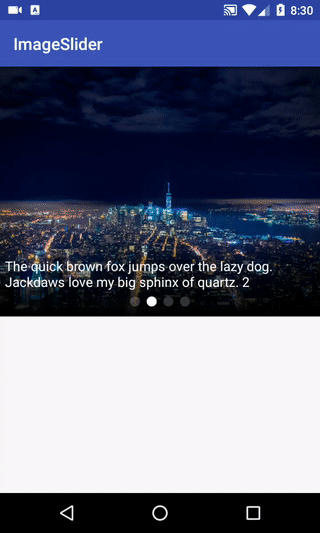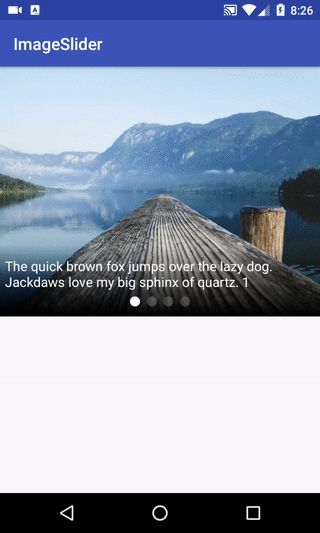Este es un sorprendente control deslizante de imágenes para el Android.
Puede cargar fácilmente imágenes con su diseño personalizado, y hay muchos tipos de animaciones increíbles que puede elegir.
implementation ' com.github.smarteist:autoimageslider:1.4.0 'Si está utilizando las bibliotecas de AppCompat, use este, pero migre a Androidx tan pronto como pueda.
implementation ' com.github.smarteist:autoimageslider:1.4.0-appcompat '



Primero coloque la vista del control deslizante en su diseño XML:
< com .smarteist.autoimageslider.SliderView
android : id = " @+id/imageSlider "
android : layout_width = " match_parent "
android : layout_height = " 300dp "
app : sliderAnimationDuration = " 600 "
app : sliderAutoCycleDirection = " back_and_forth "
app : sliderAutoCycleEnabled = " true "
app : sliderIndicatorAnimationDuration = " 600 "
app : sliderIndicatorGravity = " center_horizontal|bottom "
app : sliderIndicatorMargin = " 15dp "
app : sliderIndicatorOrientation = " horizontal "
app : sliderIndicatorPadding = " 3dp "
app : sliderIndicatorRadius = " 2dp "
app : sliderIndicatorSelectedColor = " #5A5A5A "
app : sliderIndicatorUnselectedColor = " #FFF "
app : sliderScrollTimeInSec = " 1 "
app : sliderStartAutoCycle = " true " />O puede ponerlo dentro de CardView para verse más hermoso:
< androidx .cardview.widget.CardView
app : cardCornerRadius = " 6dp "
android : layout_margin = " 16dp "
android : layout_width = " match_parent "
android : layout_height = " wrap_content " >
< com .smarteist.autoimageslider.SliderView
android : id = " @+id/imageSlider "
android : layout_width = " match_parent "
android : layout_height = " 300dp "
app : sliderAnimationDuration = " 600 "
app : sliderAutoCycleDirection = " back_and_forth "
app : sliderAutoCycleEnabled = " true "
app : sliderIndicatorAnimationDuration = " 600 "
app : sliderIndicatorGravity = " center_horizontal|bottom "
app : sliderIndicatorMargin = " 15dp "
app : sliderIndicatorOrientation = " horizontal "
app : sliderIndicatorPadding = " 3dp "
app : sliderIndicatorRadius = " 2dp "
app : sliderIndicatorSelectedColor = " #5A5A5A "
app : sliderIndicatorUnselectedColor = " #FFF "
app : sliderScrollTimeInSec = " 1 "
app : sliderStartAutoCycle = " true " />
</ androidx .cardview.widget.CardView>La nueva versión requiere un adaptador deslizante más su diseño personalizado para elementos deslizantes, aunque es muy similar a RecyclerView & RecyclerAdapter, y es familiar y fácil implementar este adaptador ... Aquí hay un ejemplo para la implementación del adaptador:
public class SliderAdapterExample extends
SliderViewAdapter < SliderAdapterExample . SliderAdapterVH > {
private Context context ;
private List < SliderItem > mSliderItems = new ArrayList <>();
public SliderAdapterExample ( Context context ) {
this . context = context ;
}
public void renewItems ( List < SliderItem > sliderItems ) {
this . mSliderItems = sliderItems ;
notifyDataSetChanged ();
}
public void deleteItem ( int position ) {
this . mSliderItems . remove ( position );
notifyDataSetChanged ();
}
public void addItem ( SliderItem sliderItem ) {
this . mSliderItems . add ( sliderItem );
notifyDataSetChanged ();
}
@ Override
public SliderAdapterVH onCreateViewHolder ( ViewGroup parent ) {
View inflate = LayoutInflater . from ( parent . getContext ()). inflate ( R . layout . image_slider_layout_item , null );
return new SliderAdapterVH ( inflate );
}
@ Override
public void onBindViewHolder ( SliderAdapterVH viewHolder , final int position ) {
SliderItem sliderItem = mSliderItems . get ( position );
viewHolder . textViewDescription . setText ( sliderItem . getDescription ());
viewHolder . textViewDescription . setTextSize ( 16 );
viewHolder . textViewDescription . setTextColor ( Color . WHITE );
Glide . with ( viewHolder . itemView )
. load ( sliderItem . getImageUrl ())
. fitCenter ()
. into ( viewHolder . imageViewBackground );
viewHolder . itemView . setOnClickListener ( new View . OnClickListener () {
@ Override
public void onClick ( View v ) {
Toast . makeText ( context , "This is item in position " + position , Toast . LENGTH_SHORT ). show ();
}
});
}
@ Override
public int getCount () {
//slider view count could be dynamic size
return mSliderItems . size ();
}
class SliderAdapterVH extends SliderViewAdapter . ViewHolder {
View itemView ;
ImageView imageViewBackground ;
ImageView imageGifContainer ;
TextView textViewDescription ;
public SliderAdapterVH ( View itemView ) {
super ( itemView );
imageViewBackground = itemView . findViewById ( R . id . iv_auto_image_slider );
imageGifContainer = itemView . findViewById ( R . id . iv_gif_container );
textViewDescription = itemView . findViewById ( R . id . tv_auto_image_slider );
this . itemView = itemView ;
}
}
}Puedes hacer tu propio diseño para ver por de control
Aquí hay un ejemplo para la implementación del adaptador:
<? xml version = " 1.0 " encoding = " utf-8 " ?>
< FrameLayout xmlns : android = " http://schemas.android.com/apk/res/android "
xmlns : tools = " http://schemas.android.com/tools "
android : layout_width = " match_parent "
android : layout_height = " match_parent "
android : orientation = " vertical " >
< ImageView
android : id = " @+id/iv_auto_image_slider "
android : layout_width = " match_parent "
android : layout_height = " match_parent "
android : scaleType = " fitXY " />
< ImageView
android : id = " @+id/iv_gif_container "
android : layout_width = " 80dp "
android : layout_height = " 80dp "
android : layout_gravity = " bottom|start "
android : layout_margin = " 50dp " />
< FrameLayout
android : id = " @+id/fl_shadow_container "
android : background = " @drawable/bg_overlay "
android : layout_width = " match_parent "
android : layout_height = " wrap_content "
android : layout_gravity = " bottom " >
< TextView
android : id = " @+id/tv_auto_image_slider "
android : layout_width = " match_parent "
android : layout_height = " wrap_content "
android : layout_marginTop = " 8dp "
android : layout_marginBottom = " 25dp "
android : padding = " 6dp "
android : textColor = " #FFF "
android : textSize = " 18sp " />
</ FrameLayout >
</ FrameLayout >Después de la instancia de Sliderview (dentro de la actividad o fragmento con FindViewById | BindView ...), configure el adaptador en el control deslizante.
SliderView sliderView = findViewById ( R . id . imageSlider );
sliderView . setSliderAdapter ( new SliderAdapterExample ( context ));Puede llamar a este método si desea comenzar a voltear automáticamente y también puede configurar la animación deslizante:
sliderView . setIndicatorAnimation ( IndicatorAnimationType . WORM );
sliderView . setSliderTransformAnimation ( SliderAnimations . SIMPLETRANSFORMATION );
sliderView . startAutoCycle ();Aquí hay un ejemplo más realista y más completo:
@ Override
protected void onCreate ( Bundle savedInstanceState ) {
super . onCreate ( savedInstanceState );
setContentView ( R . layout . activity_main );
SliderView sliderView = findViewById ( R . id . imageSlider );
SliderAdapterExample adapter = new SliderAdapterExample ( this );
sliderView . setSliderAdapter ( adapter );
sliderView . setIndicatorAnimation ( IndicatorAnimationType . WORM ); //set indicator animation by using IndicatorAnimationType. :WORM or THIN_WORM or COLOR or DROP or FILL or NONE or SCALE or SCALE_DOWN or SLIDE and SWAP!!
sliderView . setSliderTransformAnimation ( SliderAnimations . SIMPLETRANSFORMATION );
sliderView . setAutoCycleDirection ( SliderView . AUTO_CYCLE_DIRECTION_BACK_AND_FORTH );
sliderView . setIndicatorSelectedColor ( Color . WHITE );
sliderView . setIndicatorUnselectedColor ( Color . GRAY );
sliderView . setScrollTimeInSec ( 4 ); //set scroll delay in seconds :
sliderView . startAutoCycle ();
}Las sugerencias y las solicitudes de extracción siempre son bienvenidas. ¡Un agradecimiento especial [Roman Danylyk] (https://github.com/romandanylyk) por un buen indicador!
Copyright [2019] [Ali Hosseini]
Con licencia bajo la licencia Apache, versión 2.0; No puede usar este archivo, excepto de conformidad con la licencia. Puede obtener una copia de la licencia en
http://www.apache.org/licenses/LICENSE-2.0
A menos que la ley aplicable sea requerida o acordado por escrito, el software distribuido bajo la licencia se distribuye de manera "como es", sin garantías o condiciones de ningún tipo, ya sea expresas o implícitas. Consulte la licencia para los permisos y limitaciones de rigor de idioma específico bajo la licencia.